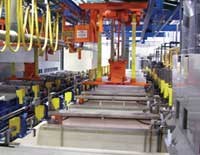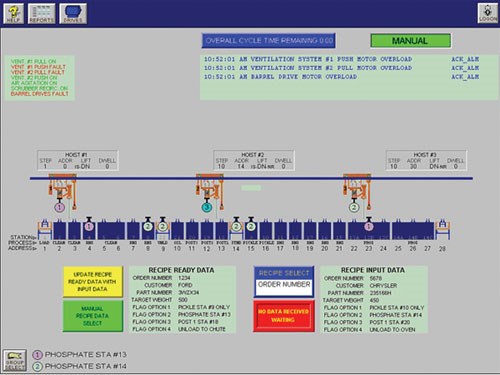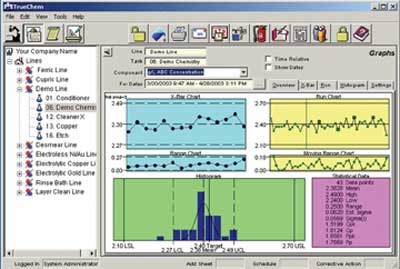Better Plating Through Automation
A look at the current state of electroplating monitoring and control systems
Although significant mechanical refinements continue to be made in surface finishing equipment, the most dramatic improvements in recent years have been made in control and monitoring systems. Advances in electronics and computer technology have provided a quantum leap that can enable surface finishers to improve process control and monitoring of their plating lines. This article reviews some of the new features that many finishers have implemented to improve their processes, meet increasingly stringent customer quality requirements, and boost their profitability.
System Hardware
Many years ago, controls for an automated finishing line consisted of multiple control relays or home-built “black box” controllers, with pushbuttons and lights for the operator interface. This was an improvement over the tried and true mechanical switch drum controls, which generally had no operator interface at all.
After the arrival of solid-state controllers came the first generation of programmable logic controllers (PLCs) with modular designs. The early interfaces to these devices were expensive one- or two-line displays that were later updated to dedicated screens that tended to be big, bulky, and also quite expensive, even though their reliability was considered somewhat sporadic at best. However, the modular PLC design, with its ease of maintenance and general availability, proved quite advantageous. Today’s PLCs are smaller and have improved speed, memory, and most importantly reliability.
The current state of the art in industrial automation controls consists of PLC controllers for managing the inputs and outputs from the field devices coupled with an industrial-grade computer (IC) for the user interface, recipe/data management, report generation, and communication with other business systems.
This combination of PLC/IC provides a very powerful system. The high speed, deterministic repeatability, and robust modular design of the PLCs makes them efficient tools to manage the ever-expanding number of both digital and analog devices that are installed on a modern plating line. While some system suppliers use an IC alone, experience has shown that using a computer-based system for the control of such devices is difficult at best due to the non-deterministic time-slicing nature of the IC and the ever-changing nature of their operating systems. PLCs remain the ideal tool for that job.
The IC, on the other hand, is an ideal tool for providing an open-vendor graphical interface and open-vendor data management tools. In many cases where companies have relied solely on ICs to run their finishing lines, they have found that they are tied to single-supplier hardware and software and become victims of the “black box” syndrome once again. They literally become hostage to a single supplier, and to the supplier’s ability to support a rapidly changing platform. With the combination of a PLC and an IC, in the case of an IC failure the system can be run with a standby laptop while the PLC is able to continue running, thereby minimizing downtime.
PLC/IC systems have other advantages as well. In many cases, they are retrofittable to existing older PLC systems, or they can be added as completely new systems to existing automated finishing lines. Also, the operator interface IC portion may be upgraded in the future without replacing the entire control system. Your equipment supplier should be able to help you analyze your situation and offer the latest in state-of-the-art controls.
System Control
After a system has been supplied with PLC/IC controls, the possibilities for control and monitoring of the finishing system are only limited by your imagination and (of course) budget. However, some monitoring and control capabilities have become pretty much “standard” on systems supplied by Jessup Engineering. Following is a discussion on some of those areas.
Recipe management can provide customers with a large number of plating “recipes” that can be managed by the IC. Using a bar code scanner, line operators can scan work tickets and have all the process data automatically uploaded to the IC to run the process. This takes manual recipe input out of the equation and allows the operator to select from a history of acceptable recipes. In addition, recipe management software can use either manually entered part quantities on racks or automatically entered barrel weights from load scales to automatically load rectifier settings and ensure proper electroplating efficiency and thicknesses based on part load.
Along with PLC/IC hardware and recipe management, modern control systems can provide users with individual process control. For example, exact rectifier settings can be automatically run. regardless of the variance in barrels or racks that may be coming into a plating bath. This has been a major improvement in plating bath control, both by improving the part finish and by helping to reduce raw materials costs.
Energy Management. Current control systems based on the PLC/IC combination also allow users to install energy management features that previously may have not been available. This can include control of such process variables as rinse water volumes, bath heating and cooling, and exhaust ventilation rates. Each facility will have different requirements, but users should work with their controls/equipment supplier to discuss which features are available to be added to their system. With rising energy and materials costs, these areas can provide significant savings on an annual basis.
System Monitoring
With updated controls systems, users have many options for monitoring of mechanical equipment on their finishing lines.
In addition to the standard systems, which typically monitor process automation, tank temperatures, pH and conductivity, chemical feed systems, pumps and ventilation monitoring, the PLC/IC can give users graphic displays of alarm conditions and problem areas. Photo-realistic graphics and actual photographs, coupled with a touch-screen operator interface for ease of use, provide an intuitive display that makes it easy to diagnose problem areas for even the least technical personnel.
Additional features can typically be added with additional engineering time. Experienced suppliers will offer additional monitoring capabilities depending upon the process being handled. These can include load tracking and enhanced communication for quality tracking and documentation purposes.
For load tracking, the PLC/IC control system can allow users to monitor all key operating parameters and assign a packet of data that travels with the part load. When processing is complete, this information packet can be downloaded to the user’s in-house system databases for collection of the part’s processing history. This capability also enables platers to provide additional documentation to their customers confirming that the process parameters were maintained within
specifications.
System Reporting
Modern PLC/IC control systems typically offer standard reporting features that can be customized by end users. These can include alarm, production and maintenance reports. User-settable security levels allow managers to control access to various portions of the information.
Alarm reports. Standard systems should include alarm history reports that log times and dates of alarm events and record the operators who acknowledge the condition. If desired, these alarms can be tracked to determine a follow-up condition.
Modern plating line control systems will normally include a shift-end or day-end type report that records the critical items for the company. These can be used to determine efficiency of different shifts or individual operators. Some companies even use these reports to determine base/reward pay plans.
The controls package also can be designed to generate normal preventive maintenance schedules that are based either on operating hours, number and size of loads processed, or any other user requirement. These can be tied into the user interface, which requires that line operators and other personnel acknowledge the needed maintenance and thus ensure the proper maintenance of the machines. This feature can help to minimize system downtime and reduce spare part and operating costs.
PLC/IC systems can be supplied with many layers of security, which can be specified by the end user. Security levels can vary from the shop-level operator, plant engineer, shift manager, up to plant manager or even president. Access that would allow changes to process parameters can be set to allow input by only the predetermined individuals.
Data Management
Modern manufacturing facilities generate significant amounts of data. Unfortunately, use of cumbersome in-house databases, with less-than-adequate or poorly documented processes, is common in finishing and other manufacturing operations. However, a well-designed database can provide a single source for all information pertinent to a particular process or operation.
Such a database can stream-line the cost of internal and external audits, which are continuous requirements in manufacturing. Historical data can be made readily available to assist in preventing or troubleshooting problems, as well as to easily satisfy the many regulatory compliance requirements and customer auditing exercises that are common in today’s manufacturing.
The database needs to be secure, yet easily accessible for immediate review, auditing and reporting. If properly built and maintained, a company’s database can play a major role in producing consistent product and increasing efficiency in operations.
To achieve both consistency and efficiency, manufacturers must not only collect inordinate amounts of data, but they need easy access to that data for decision-making purposes. This is being accomplished by companies using relational databases, which are fast, flexible and secure, and do not require users to have any knowledge of the database architecture or structure.
There are companies developing “standard” database systems designed specifically for the surface finishing industries. Such databases provide a single focal point to control and automate the management of chemistries, processes, methods and procedures and documentation. They can also provide active monitoring of process variables, and statistically analyze those variables to allow more effective control and automate process management. Visualization tools provide a “dashboard” that graphically represents the analysis.
A typical database software package can give users many options for managing their finishing operations. At a minimum, database software should provide a best practices framework, be configurable for any process or chemistry, and provide advanced statistical analysis such as process capabilities and other metrics. User-configurable capability to provide test procedures, business rules, schedules, add slips, corrective actions, event tracking, security, and escalation procedures is also desirable.
In summary, an effective database software package will be designed to specifically control and automate the management of chemistries, coatings and any wet processing. It will ensure consistent, repeatable application of best practices, and digitize the process and all activities, computations and data logging to ensure that the defined methods and procedures are consistently executed.
Many finishers are seeing new control systems as their best route to maintaining their competitive future. In some cases, upgrading the control system on an existing line can provide a return on investment in a relative short period of time. The question going forward is not whether one needs to be on the leading edge, but whether one can afford not to be.
Related Content
Liquid Chrome Vs. Chromic Acid Flake
Contemplating how to continue offering chromic acid services in an increasingly stringent regulatory world? Liquid chrome products may be the solution you’re looking for.
Read MoreSuccessful South African Plater Beating the Odds
Remaining focused on quality and reliability, Team Plating Works stays profitable in a volatile and challenging economy.
Read MoreHow to Choose Between Sulfate and Chloride-Based Trivalent Chromium
There are several factors to consider when choosing between sulfate and chloride-based baths for trivalent chromium plating. Mark Schario of Columbia Chemical discusses the differences and what platers should keep in mind when evaluating options.
Read MoreAdvantages to Pumped Eductor Agitation
Not all agitation methods are created equally. Pumped agitation with eductor nozzles can improve process tanks and quickly show a reduction in operating costs while keeping staff safe, following environmental legislation and preventing pollution.
Read MoreRead Next
Education Bringing Cleaning to Machining
Debuting new speakers and cleaning technology content during this half-day workshop co-located with IMTS 2024.
Read MoreDelivering Increased Benefits to Greenhouse Films
Baystar's Borstar technology is helping customers deliver better, more reliable production methods to greenhouse agriculture.
Read MoreA ‘Clean’ Agenda Offers Unique Presentations in Chicago
The 2024 Parts Cleaning Conference, co-located with the International Manufacturing Technology Show, includes presentations by several speakers who are new to the conference and topics that have not been covered in past editions of this event.
Read More

















.jpg;maxWidth=300;quality=90)











